This morning I headed south to join a group of birders at the Wildflower Center. Since I don’t have a dedicated set of binoculars (yet), I can’t officially call myself a “real” birder, based on my personal definition, but given that I got up at 6am to drive across town to trek along trails and into woods to find our avian friends, I guess I might as well stop fooling myself. Our guide Travis loaned me a set of binoculars, though — thank goodness, because my zoom lens only goes so far. Note to self: Add birding binoculars to my wish list. Might as well add a bigger zoom to that list, too.
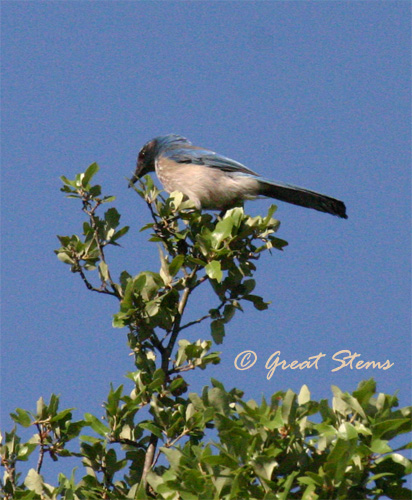
Western Scrub-Jay
Today we hoped to see the Painted Buntings that have arrived at the Wildflower Center, but of course we took a full walk around to see as many birds as possible. The key to finding a bird on a wildlife walk among trees and shrubs is to keep a keen eye watching for movement and a careful ear listening and distinguishing bird calls. Even then, there’s no guarantee you’ll see what the person next to you caught a mere glimpse of, and there were several birds we never saw at all but only heard. There’s a whole trick to finding birds through binoculars, too.
Northern Cardinals and Northern Mockingbirds greeted us the most with song, though I suspect it had far less to do with us and far more to do with their mates.
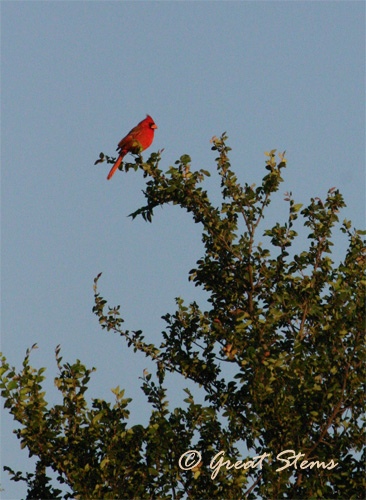
Among the 30 species of birds we caught glimpses of or recognized the sounds of were White-Eyed Vireo, Bewick’s Wren, Downy and Ladder-Backed Woodpeckers, Brown-Headed Cowbird, Lesser Goldfinch, Cooper’s Hawk, Estern Phoebe, Bobwhite Quail, and oh so many more.
As hard as it was to find the birds, even with binoculars, it was even harder to get a picture with the camera. Here is the only evidence I have of the Black-Throated Green Warbler we saw — it moved just as I got into position to get a photo:
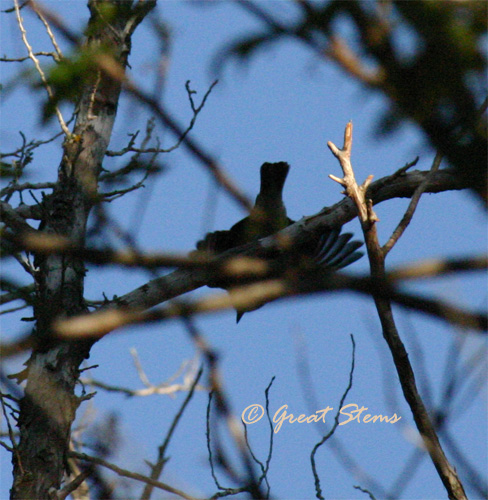
This next pitiful picture hides a Yellow Warbler. See it?
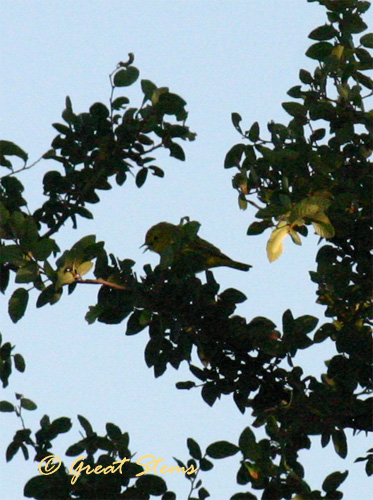
Alas. At least the nearby flowers cooperated. You know me, I couldn’t help but appreciate the beauty of the flowers while I listened to the birds.
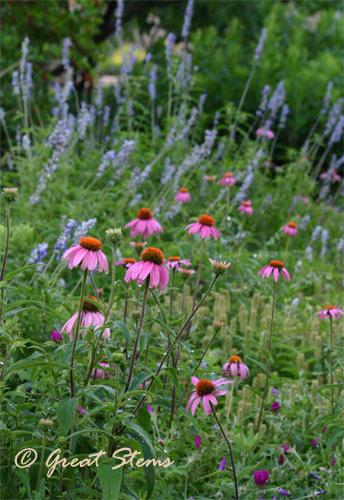
Above, the ever-beautiful Purple Coneflowers commanded attention from their blue backdrop of Mealy Blue Sage, and below, a bee took a pollen bath in a Winecup.
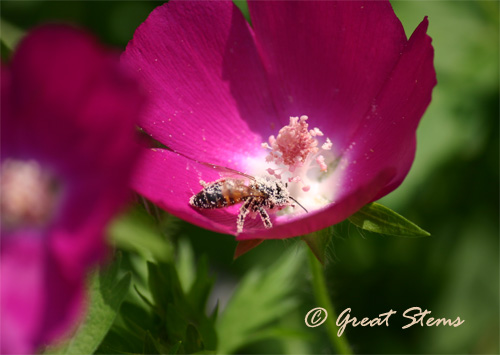
A Carpenter Bee took a rest on Antelope Horn Milkweed.
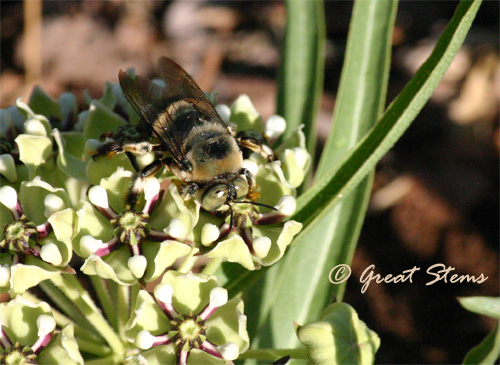 But I digress.
But I digress.
The Great Horned Owlets continue to do well, and we took a few moments to visit them, being cautious not to linger too long.
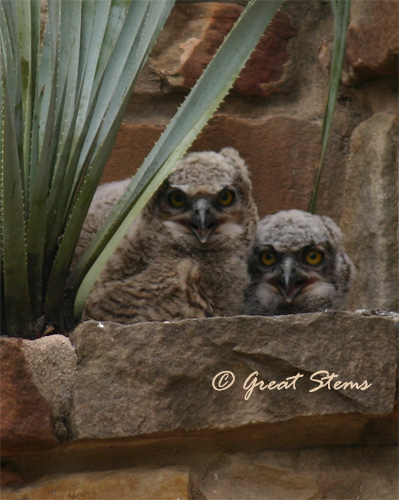 There are three of them, but the prime hiding spot is behind the sotol, so capturing a picture of all three at once was a challenge. I felt lucky to get “the eye” of the third.
There are three of them, but the prime hiding spot is behind the sotol, so capturing a picture of all three at once was a challenge. I felt lucky to get “the eye” of the third.
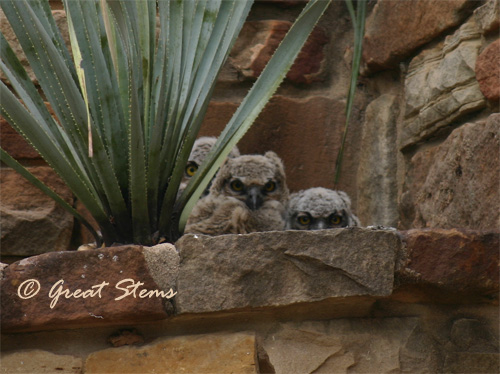 I’m cheating here — the above images and the one below I actually took two days ago during another visit to the Center — look how big the owls are growing. I think the one standing tall in the image below might actually be the youngest baby — see how the others are farther developed in their plumage? The Center’s staff is keeping an extra watch on it.
I’m cheating here — the above images and the one below I actually took two days ago during another visit to the Center — look how big the owls are growing. I think the one standing tall in the image below might actually be the youngest baby — see how the others are farther developed in their plumage? The Center’s staff is keeping an extra watch on it.
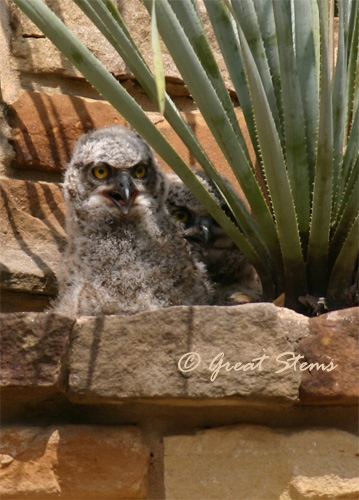 Now take a look at the owls this morning. With the cooler temperature, they were fluffed up, but what a difference in plumage two days can make.
Now take a look at the owls this morning. With the cooler temperature, they were fluffed up, but what a difference in plumage two days can make.
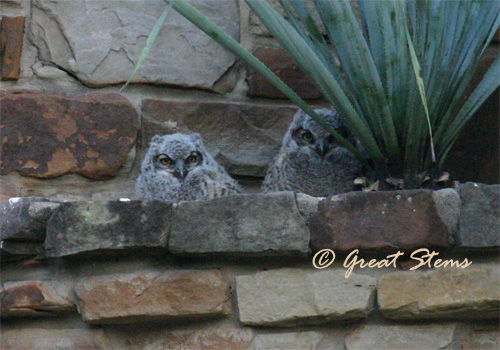
We didn’t see Mama Owl (or Papa Owl, for that matter), but I’m sure she was watching us from afar. She no longer stays in the nest with her babies — they are so big! — but she continues to feed them during off hours.
As for Painted Buntings, we heard several but only saw a couple from quite far away. They just didn’t care to let us get close. This very-zoomed-in photo, my friends, is the best I have to show you.
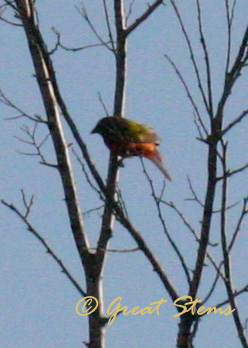 But we saw them — that’s what counts!
But we saw them — that’s what counts!
I think the “runt” is not actually a runt, but the last chick hatched. They can hatch several days apart, and from your pictures you can see how fast they grow. So, one just a week older will be significantly larger. The little guy will be fine.
Antelope horn milkweed – that is a beautiful flower, striking combination of colours.
I agree, Travis — that was my bad for quoting someone I spoke with a couple of days ago. Yes, it’s certainly the youngest, and I’ve corrected the post. But the Wildflower staffperson did say that they were watching the nest in case the older birds pushed the younger one out early. Not sure if that’s actually a behavior of owls or not, but it’s clear how much everyone at the WFC cares about the owlets and wants them all to succeed!
That’s a dedicated staff. It’s not easy making new puppets every couple of days. 😉
Birding: It seems like you either have to look through the camera the whole time, or just give up and enjoy seeing the birds with “your eyes only”, otherwise it’s a stressful, disappointing time. The “best” birds to sight are the ones that don’t really want to sit still. That’s why I like watching mourning doves. Very low-pressure. 🙂
Funny you should say that, Alan — the mourning doves were super easy to notice because they always startled easily and kept flying around. Never managed to see one staying still!
a slight variation to your cardinals over here is called burung chandik.
Another bunch of wonderful photos. I feel lucky to be able to view the family of owl and owlets. 🙂 I would be jumping with joy if I could snap a photo of them. So far, I hardly have any decent photos of birds.
Meredith,
You’ll find the Painted Buntings perhaps on the next time. You might look into Eagle optics binocs good quality and not too expensive.
The owlets have grown so much! They’re getting their “ear tufts” too. I need to go back and see for myself.
We had a beautiful Daddy cardinal outside the office window this morning. I love your pictures of the fuzzy owlets! Even the silhouette shots of the birds are beautiful!
And I especially love, love your Easter rocks idea. I will be sharing that with my sister for my young niece and nephew for next year!
It doesn’t take binoculars to be a birder! You’re a fabulous birder! Great post!!